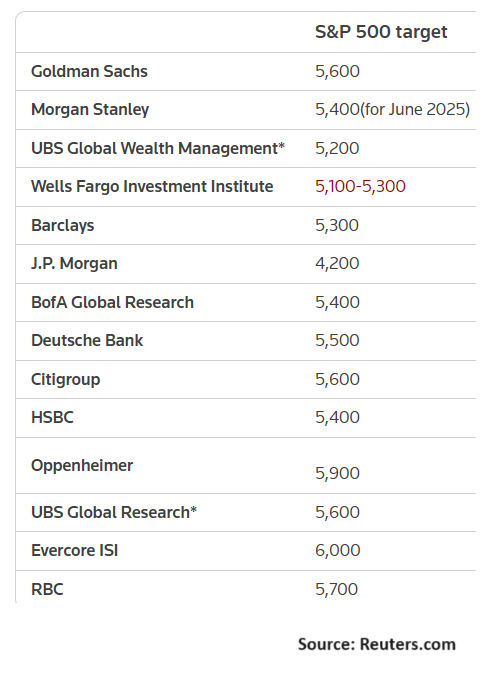If the S&P 500 flatlines from current levels through Dec. 31, 2024, the market would still go into the history books as delivering yet another strong year on the basis of an 18.1% year-to-date rise through Monday (July 15). But the best may be yet to come, some Wall Street firms predict.
Reuters reports that
“Brokerages have raised their year-end targets for US stocks benchmark S&P 500.”
The catalysts for the optimism:
“Expectations of a ‘soft landing’ for the economy and growing odds the Federal Reserve will cut interest rates this year.”
Two of the firms in the list below expect the S&P 500 will rise well above yesterday’s 5631 close by the end of the year. Some shops expect the market to basically trade in a range, and a few see the market falling.
CapitalSpectator.com’s view is that the market looks overbought, as discussed last week. The question is whether interest-rate cuts and an economy that slows but avoids recession will keep the party going.
Using the latest nowcast (July 10) from the Atlanta Fed’s GDPNow model as a proxy for the US economy’s near-term outlook certainly paints an encouraging profile. The upcoming Q2 data is projected to show output rose 2.0%, an improvement over Q1’s tepid 1.4% rise.
Meanwhile, Fed funds futures are pricing in a series of rate cuts in the months ahead. The crowd is confident that the Federal Reserve will start trimming its target rate at the Sep. 18 FOMC meeting.
Federal Reserve Chairman Powell seems to be leaning in that direction. Yesterday he said:
“We didn’t gain any additional confidence in the first quarter, but the three readings in the second quarter, including the one from last week, do add somewhat to confidence” that inflation is trending closer to the Fed’s 2% target.
Reading the macro tea leaves, Ed Yardeni at Yardeni Research last week raised his S&P target.
We are raising our yearend target for the S&P 500 to 5800 from 5400. We are still targeting 8000 by the end of the decade. The stock market seems to be discounting our Roaring 2020s scenario faster than we expected. We’ve been among the most bullish investment strategists since November 2022, but not bullish enough.
It’s easy to be optimistic when the market is rising and continues to take out previous targets. How long this can continue is unclear, as always. For conservative investors with short time horizons and/or low-risk tolerances, the case for rebalancing, or perhaps adopting a more defensive position, looks compelling. But the optimists say it’s premature to pivot to risk-off, and they have a point, and long-term investors and/or those with high-risk tolerances can afford to agree.
Indeed, several market metrics that focus on the trend continue to suggest that prices will rise. Similarly, the sight of the S&P continuing to set new highs implies that a correction isn’t imminent.
On the assumption that the peak for the market cycle, whenever it arrives, will only be clear after the fact, the challenge for investors is deciding whether they want to be early or late to the regime shift. Each has its own set of pros and cons.
Meanwhile, optimism prevails and the market action remains bullish. When that changes, it’ll be obvious trend metrics. The only thing we know for sure is that the turning point didn’t start on Monday.
